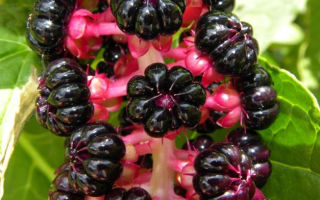Content
- 1 What kind of plant "Lakonos"
- 2 Useful properties of the lakonos plant
- 3 What is useful lakonos
- 4 Medicinal properties and use of lakonos
- 5 Lakonos recipes for treatment
- 6 Rules for the use of lakonos for medicinal purposes
- 7 Lakonos application
- 8 Limitations and contraindications
- 9 Collection, procurement, storage of raw materials
- 10 Conclusion
The healing properties of the lakonos plant help with many diseases. But sometimes phytolacca can harm, therefore, before using it, you need to carefully study its valuable and dangerous properties.
What kind of plant "Lakonos"
Lakonos, or phytolacca, is a perennial shrub or tree-shaped plant from the Lakonosov family. The plant's stems are thick and branched, the shrub can reach 3 m in height. The plant is covered with large elliptical leaves up to 20 cm in length, light or dark green in color.
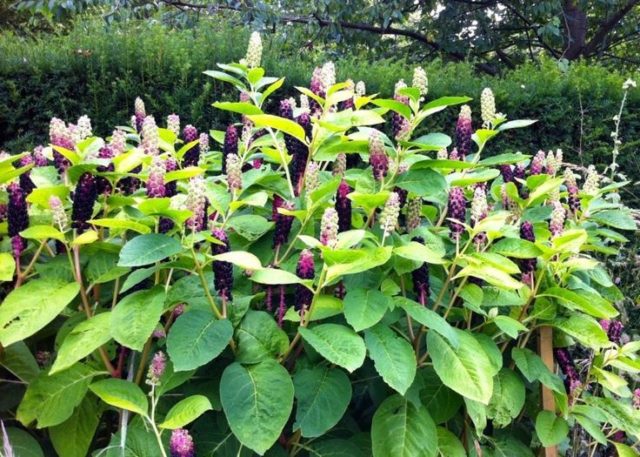
Lakonos bears juicy fruits - purple-black berries that resemble raspberries or blackberries. Both the berries and the green parts of the lakonos contain many useful substances, thanks to which the plant acquires medical significance.
Lakonos species
In total, botany distinguishes more than 25 varieties in the genus Lakonosov. But only 3 types are most widespread and popular:
- American Lakonos. The shrub can grow up to 2 m, has oval light green leaves and erect light green inflorescences.
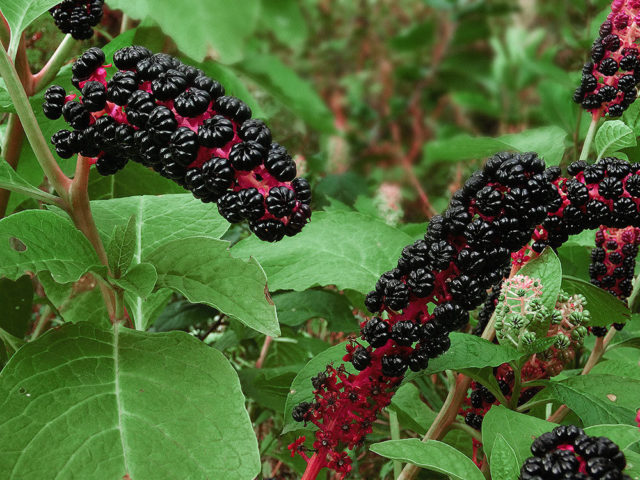 In autumn, the shrub bears black fruits, which can hold on to the shoots until the onset of frost
In autumn, the shrub bears black fruits, which can hold on to the shoots until the onset of frost - Berry lakonos. The plant reaches 1.5 m in height, blooms with white or greenish flowers, and bears conditionally black edible fruits.
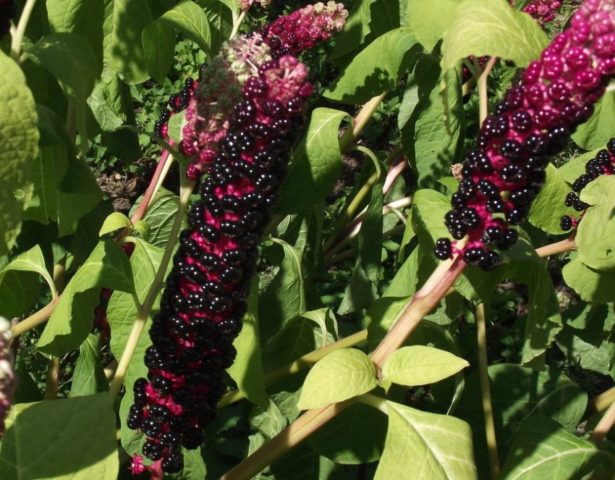 The berry variety is distinguished by its brightness and average height of the bush.
The berry variety is distinguished by its brightness and average height of the bush. - Lakonos claviferous. In appearance, it differs from other varieties in very large leaves - up to 30 cm in length. The berries of the club-like lakonos are also black and ripen in autumn.
 The plant blooms not white, but purple-pink flowers
The plant blooms not white, but purple-pink flowers
For medicinal purposes, the properties of fruits, leaves and rhizomes of all the listed species are used. It should be noted that Lakonos requires careful pre-processing - raw berries can be harmful to health.
Lakonos is poisonous or not
Wild lakonosy are highly poisonous because they contain many saponins in their fruits, leaves and roots. However, cultivated varieties have much less toxic substances.
Despite this, for medical use, garden laconos must be heat treated. And even after it, home remedies from the plant are used in small dosages.
Useful properties of the lakonos plant
Phytolacca is widely used in folk medicine. The plant contains many vitamins, mineral salts and useful acids, and both the berries of the lakonos and its leaves and roots have medicinal value.
Medicinal properties of lakonos berries
Fresh and dried fruits of phytolacca can help cure many diseases. In particular, they benefit:
- with sore throat and sore throat;
- with diseases of the stomach and intestines;
- with hemorrhoids;
- with boils and lichen;
- with hypertension and high cholesterol;
- with dermatitis and acne;
- with rheumatism and radiculitis.
Decoctions and infusions based on berries are used for kidney ailments and colds.
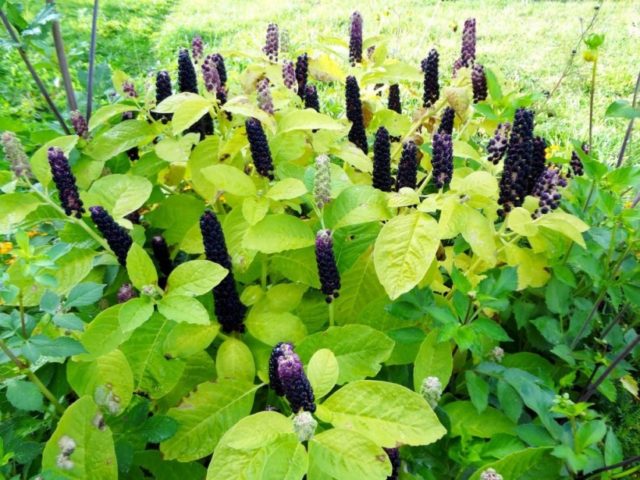
Is it possible to eat the berries of the American lakonos
The American lakonos can most often be found in summer cottages in Russia. Although its dark berries look very appetizing, it is not recommended to eat them raw. Even the cultivated lakonos is advised to pre-boil and then take in an amount of no more than 2 berries per day.
The healing properties of the root of the lakonos
The roots of the lakonos, like its leaves, are quite toxic when fresh and are suitable only for external use. But after boiling or insisting, they can be used as a remedy for:
- rheumatism;
- weakened immunity;
- internal inflammation;
- colds;
- diseases of the gums and throat.
Lakonos root is also used for the prevention of oncology. Medicines based on it stimulate the processes of cellular renewal in the body and do not allow the development of malignant tumors.
What is useful lakonos
Phytolacca is recommended for men for use mainly for prostatitis and inflammation of the genitourinary system. Due to its strong antiseptic properties, the plant improves health and prevents the development of malignant processes. Lakonos also helps with recovery from a heart attack.
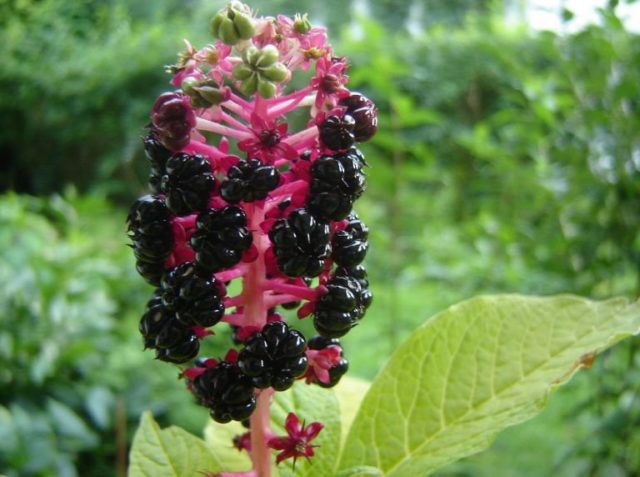
For women, lakonos can serve as a good prevention of fibroids, fibroids and breast cancer. The beneficial properties of the plant are manifested in the treatment of migraines, with feverish conditions and ailments of the lymphatic system. These features make lakonos in demand for women during menopause.
But for pregnant women, phytolacca-based preparations are strictly prohibited. Even after treatment, the plant remains slightly toxic, moreover, its properties have not yet been fully studied. You can not take phytolacca and nursing mothers.
It is also forbidden to give lakonos to children as a medicine. It is possible to use the plant for medicinal purposes only after 18 years, when the possible side effects will no longer cause irreparable harm to the body.
Medicinal properties and use of lakonos
It is possible to use phytolacca remedies for many ailments, from inflammation, gastric disorders, with a decrease in immunity. But most often the lakonos is brewed and drunk or used externally for several diseases.
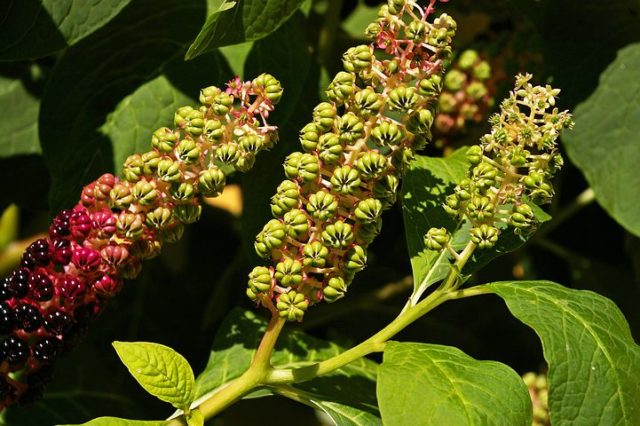
With hemorrhoids
Hemorrhoids are well helped by a medicinal ointment based on lakonos roots. Do it as follows:
- the roots of the plant are dried and then crushed into a homogeneous powder;
- a small portion of the powder is combined with a fat base in a ratio of 1 to 10, you can use pork fat, petroleum jelly or butter;
- the product is thoroughly mixed until smooth.
The ointment is applied to a cotton swab or piece of gauze and applied to the anus for about 20 minutes. The procedure is repeated daily, 2 times a day until the symptoms disappear.
For the spine and joints
For arthritis, osteochondrosis and arthrosis, it is useful to make medical compresses. The procedure looks like this:
- in a tincture on the roots and leaves of the plant, a small bandage is moistened, folded several times;
- apply a compress to a sore spot;
- fixed with a dense cloth on top and held for about 2 hours.
It is best to carry out the procedure in the evening, in order to immediately rest the joints.The beneficial properties of the plant will relieve pain and swelling, thereby improving joint mobility.
For skin diseases
For dermatitis, eczema, lichen, boils and other skin diseases, a leaf-based ointment helps. They do it like this:
- leaves are dried and chopped finely;
- mix raw materials with 2 tablespoons of pre-melted butter;
- apply to the affected area in the morning and evening.
The ointment disinfects the skin area, has a calming effect, relieves inflammation and helps restore the epidermis.
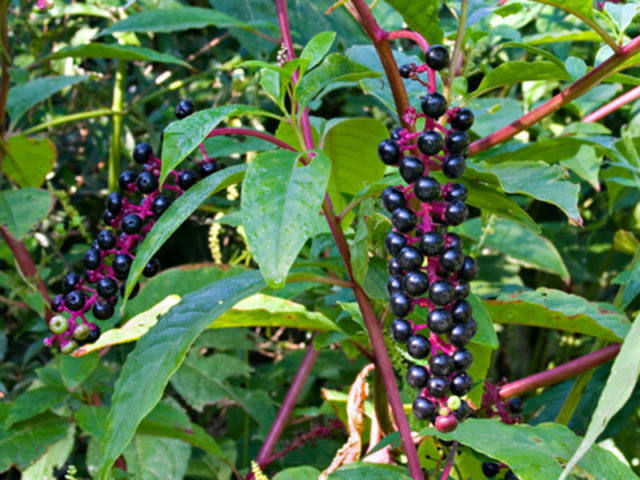
For boils, it is also recommended to simply apply fresh leaves to the inflamed areas. You need to keep them for about 20 minutes every two hours. If desired, the leaves can be crushed into gruel, then juice will be released from them, and the compress will become even more effective.
For diseases of the throat and oral cavity
For angina, stomatitis, gum inflammation and other ailments, the laconos is taken orally and used for rinsing. The properties of alcoholic tincture on crushed roots help best of all, 2 large tablespoons of dry powder are poured into 150 ml of alcohol and insisted for 20 days.
For the treatment of tonsillitis and other inflammations, the tincture is taken orally only 10 drops three times a day. For rinsing, take 1 large spoonful of the product and dilute it in a glass of water.
Lakonos recipes for treatment
In addition to the listed recipes, traditional medicine offers several more ways to use phytolacca. The parts of the plant can be used to prepare products for internal use and external treatment.
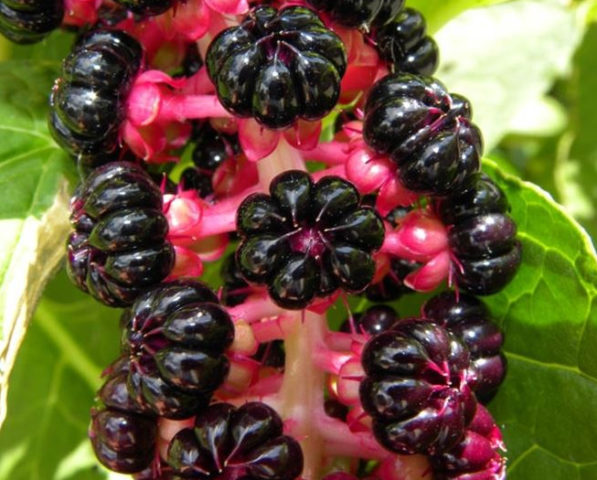
Water infusion on leaves and roots
For any inflammation and weakened immunity, ordinary water infusion helps well. To prepare it you need:
- pour hot water over 1 large spoonful of dry roots and leaves of the plant;
- close the container with a lid and insist for an hour;
- strain and drink a few sips every 3-4 hours.
The infusion compensates for the lack of nutrients in the body and has an anti-inflammatory effect. With sluggish digestion, it can speed up the metabolism, but it is very important to observe small dosages.
Decoction of fruits and leaves of lakonos
For constipation, as well as for diseases of the respiratory organs, you can use a decoction of the plant. Prepare it like this:
- 1 small spoonful of dried fruits and leaves is poured with 500 ml of boiling water;
- for 5 minutes, boil the product over low heat;
- under the lid, the broth is infused for another hour, and then filtered through cheesecloth.
You need to drink the remedy in a large spoonful on an empty stomach three times a day. In total, treatment is continued no longer than 5 days in a row. The broth has good diuretic properties, so you can also take it for edema and urogenital inflammation.
Lakonos tincture on alcohol
For colds and coughs, alcohol tincture is used. It is not difficult to make it, for this you need:
- grind dry phytolacca roots in the amount of 1 large spoon;
- pour raw materials with 250 ml of alcohol and close the container with a lid;
- insist the product in the dark for 2 weeks.
The strained tincture is used 10-20 drops three times a day to strengthen immunity and relieve cold symptoms.
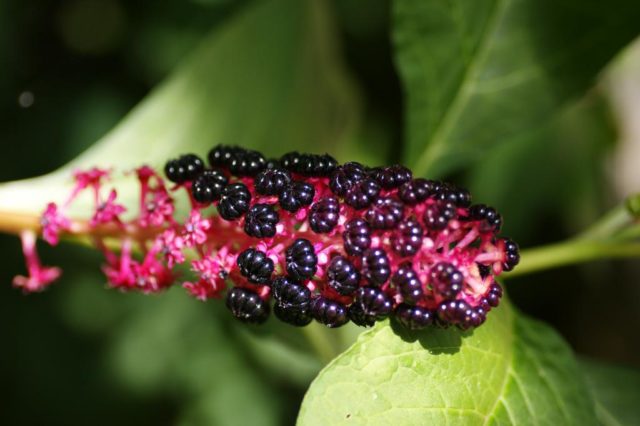
Phytolacca tincture ointment
For skin and joint diseases, the following ointment gives a good effect:
- 1 large spoonful of pork fat or lanolin is mixed with 2 ml of alcoholic tincture of lakonos;
- liquid ointment is well stirred until completely homogeneous;
- with light but strong movements, the composition is rubbed into the problem area.
Rubbing should be carried out three times a day, the ointment has a strong anti-inflammatory and analgesic effect.
Rules for the use of lakonos for medicinal purposes
Even the garden lakonos remains a plant with mild toxic properties. When using it, it is especially important to follow a number of rules, namely:
- strictly follow the instructions and dosages indicated in the medicinal recipes;
- do not use lakonos products during pregnancy and breastfeeding;
- do not treat children and adolescents under 18 years of age with phytolacca;
- do not use phytolacca internally and externally for a long time, more than 7 days in a row.
At the first external application of infusions, ointments or tinctures, it is recommended to conduct a test - apply the remedy to the delicate skin at the elbow and wait. If skin irritation does not appear within a couple of hours, then you can continue using the product.
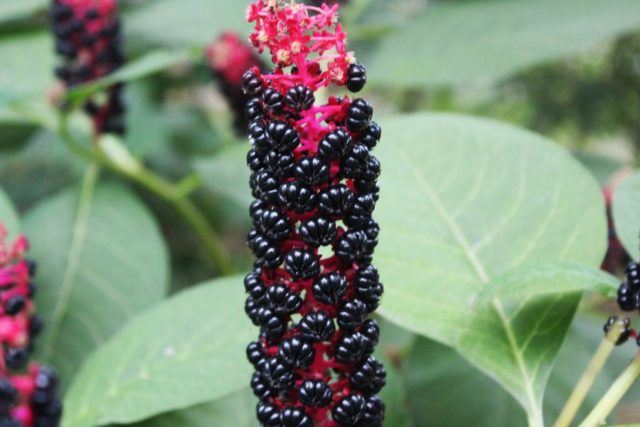
Lakonos application
In addition to traditional medicine, the properties of phytolacca are used in several other areas. Even traditional medicine recognizes the benefits of the plant; lakonos is also used in everyday life.
In homeopathy
In pharmacies, you can find homeopathic supplements based on lakonos, such as Phytolacca tincture. It is recommended to use such funds for fever, rheumatism, sciatica, migraines and pharyngitis, sore throat and cough. Homeopathic remedies from phytolacca have a good effect on the lymphatic and nervous system, although they are not a full-fledged remedy.
In modern medicine
The properties of the lakonos are used by the pharmaceutical industry. On the basis of the plant, anti-inflammatory drugs are made for the treatment of angina, bronchial asthma and pharyngitis, for example, Merifit and Anginol. Phytolacca is also part of the preparations Fitolactin and Akofit, they are used for therapy with sciatica, polyarthritis and varicose veins.
For other purposes
Lakonos is a very popular ornamental plant in summer cottages. It is often planted as part of flower beds and flower beds, decorates bare walls and fences with it, and is used for single planting and in mixborders. Since lakonos is a strong natural dye, woolen and silk fabrics are dyed with its juice. In minimal quantities, nectar is used as a food coloring.
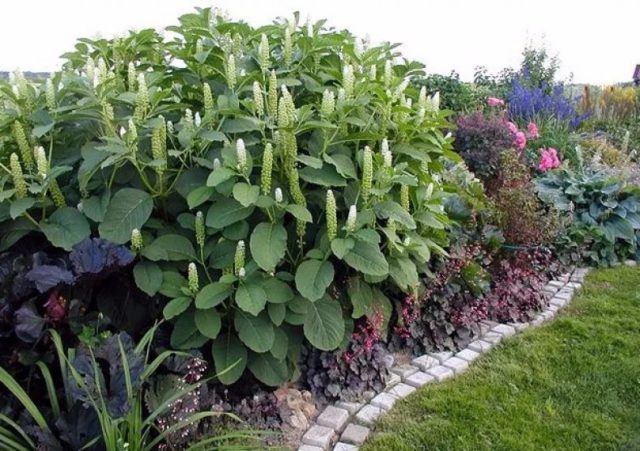
With any use of the lakonos, it must be remembered that the plant is poisonous. Children or people with sensitive skin should not wear fabrics dyed with phyto-lacquer. It is recommended to plant lakonos in the garden only if animals or small children cannot taste it on the site.
Limitations and contraindications
Although phytolacca can be dangerous, it has few contraindications. These include:
- pregnancy and breastfeeding;
- minor age;
- allergy to lakonos or a general tendency to allergic reactions.
When applied externally, phytolacca is quite safe if there is no increased dermatological sensitivity. Taking plant-based products internally is also not advised for acute digestive ailments.
Collection, procurement, storage of raw materials
Lakonos leaves can be harvested throughout the growing season, from spring to autumn, until the foliage begins to turn yellow. The berries of the plant are harvested during the fruiting period, after they become black, this happens in early autumn. At the same time, you can dig out phytolacca rhizomes. Since the pomace juice can irritate the skin, wear heavy gloves when collecting.
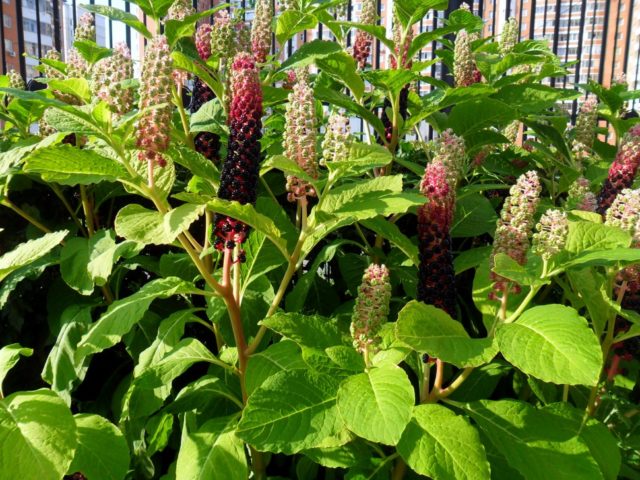
After collecting, all parts of the medicinal plant are usually dried in the fresh air or in a dryer at 40-50 ° C. Store dry raw materials in linen bags in a dry and well-ventilated place. The shelf life of medicinal raw materials is 1-2 years.
Conclusion
The medicinal properties of the lakonos plant help reduce the symptoms of skin, joint and inflammatory ailments. But you need to use the plant with caution - wild and garden phytolacca is poisonous.

